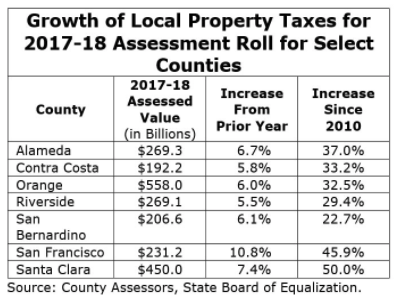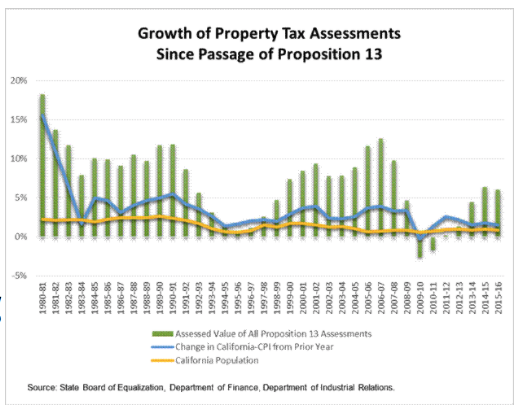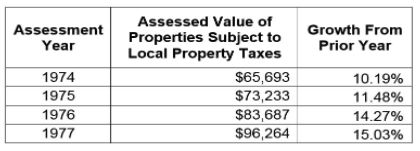 The year 1978 might seem almost like ancient history – a distant memory for most voters, and unimaginable for a growing class of lawmakers who were not yet born then. With the passage of time, folklore prevails and myths sometimes come to overshadow facts. It is in this light that opponents of Proposition 13 have succeeded in making many false claims about the landmark property tax reform initiative.
The year 1978 might seem almost like ancient history – a distant memory for most voters, and unimaginable for a growing class of lawmakers who were not yet born then. With the passage of time, folklore prevails and myths sometimes come to overshadow facts. It is in this light that opponents of Proposition 13 have succeeded in making many false claims about the landmark property tax reform initiative.
One of the most often cited claims by opponents of the 1978 ballot measure is that “Proposition 13 eviscerated local revenue.” Nothing could be further from the facts. The truth is that since 1978, local property tax assessments in California have increased by 856.48 percent.
This year alone, local property tax assessments are expected to increase an average of 5.5 percent, amounting to billions of dollars in additional funding for local schools, libraries, fire and police departments, parks and recreation programs, public health programs, streets and transit.
Since the Great Recession, property tax assessments have soared, as the chart above illustrates. Santa Clara County alone has seen 50 percent growth in its assessment roll. San Francisco’s property assessments grew 10.8 percent just this year, and have grown almost 46 percent since 2010.
While Proposition 13 limits property taxes to 1 percent of a property’s assessed value, and caps how fast a property’s taxes can increase each year, the aggregate revenue growth has been substantial.
Proposition 13 protects property owners by capping the growth of a property’s assessed value to 2 percent per year, absent a change in ownership or new construction, but the point that many critics of Proposition 13 fail to account for is that aggregate figures are much higher than 2 percent. Only in the depths of the state’s worst recessions (1994-1996 and 2009-2012) have Proposition 13 property taxes failed to grow more than 2 percent per year. Even then, property tax assessments still grew faster than inflation.
 To say that Proposition 13 limits property tax growth to 2 percent per year is also misleading. The growth of property tax assessments has far outpaced inflation and changes in California’s population. The chart on the right shows that since passage of Proposition 13, assessments have grown at an average rate of about 7.07 percent per year. In contrast, inflation has grown at an average annual rate of 3.57 percent, and population has grown at an average rate of 1.43 percent.
To say that Proposition 13 limits property tax growth to 2 percent per year is also misleading. The growth of property tax assessments has far outpaced inflation and changes in California’s population. The chart on the right shows that since passage of Proposition 13, assessments have grown at an average rate of about 7.07 percent per year. In contrast, inflation has grown at an average annual rate of 3.57 percent, and population has grown at an average rate of 1.43 percent.
The trajectory of local property tax assessments is quite similar to the growth of property taxes prior to Proposition 13. From 1945-46 to 1977-78, property assessments grew at an average rate of 7.93 percent. However, what most people remember is the voter outrage during the property tax revolt in the years leading up to passage of Proposition 13. In this era (as seen in the chart below), property tax assessments were skyrocketing by as much as 15 percent from one year to the next.
 To make matters worse for property owners during that era, county assessors were reassessing properties at three- to five-year intervals, so property owners were hit with massive increases in their property tax bills every few years, with no way to anticipate how high the bill might be.
To make matters worse for property owners during that era, county assessors were reassessing properties at three- to five-year intervals, so property owners were hit with massive increases in their property tax bills every few years, with no way to anticipate how high the bill might be.
It’s hard to imagine what it was like to open the mail and not know how much your property tax bill would be – or whether you would be able to afford to pay the tax and continue living in your home or operating your business. Proposition 13 changed this. Instead of setting your property tax based on standards such as the sales price of your neighbor’s house, Proposition 13 bases the property tax on acquisition value – usually the purchase price, an objective standard that generally is not disputed – plus 2 percent per year. The cap ensures that even as the aggregate property tax assessments grow, individual taxpayers are protected.
Myths about Proposition 13 have been common since 1978, and have included scare tactics about Proposition 13 ostensibly eviscerating local revenue. Voters were told that the San Francisco Public Library would shut its doors if Proposition 13 passed. Today, the library is open seven days a week, and has expanded its services to include computer lending, free lunches during the summer for anyone under the age of 19, and more. Los Angeles County said all beaches would be closed. Summer beachgoers in 2017 have many surf and sun options. The Los Angeles Unified School District said competitive high school sports could be eliminated if Proposition 13 passed. This year, the district will participate in 579 sporting events.
Discussions about Proposition 13 should not be framed by myths and misleading statements. To evaluate Proposition 13, tangible data from state and local sources must be used to inform the debate.
Love Proposition 13 or hate it, the data shows that it has provided a stable and growing source of revenue for local government.

